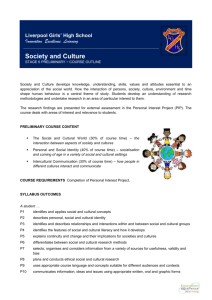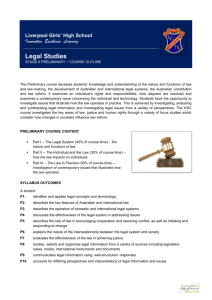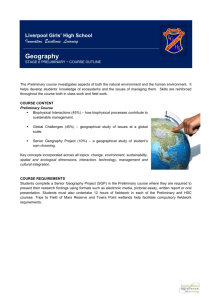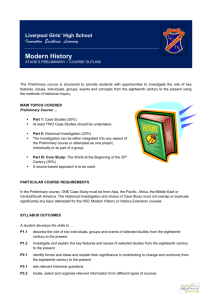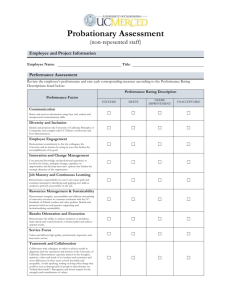Mathematics Course Outline - Liverpool Girls` High School
advertisement
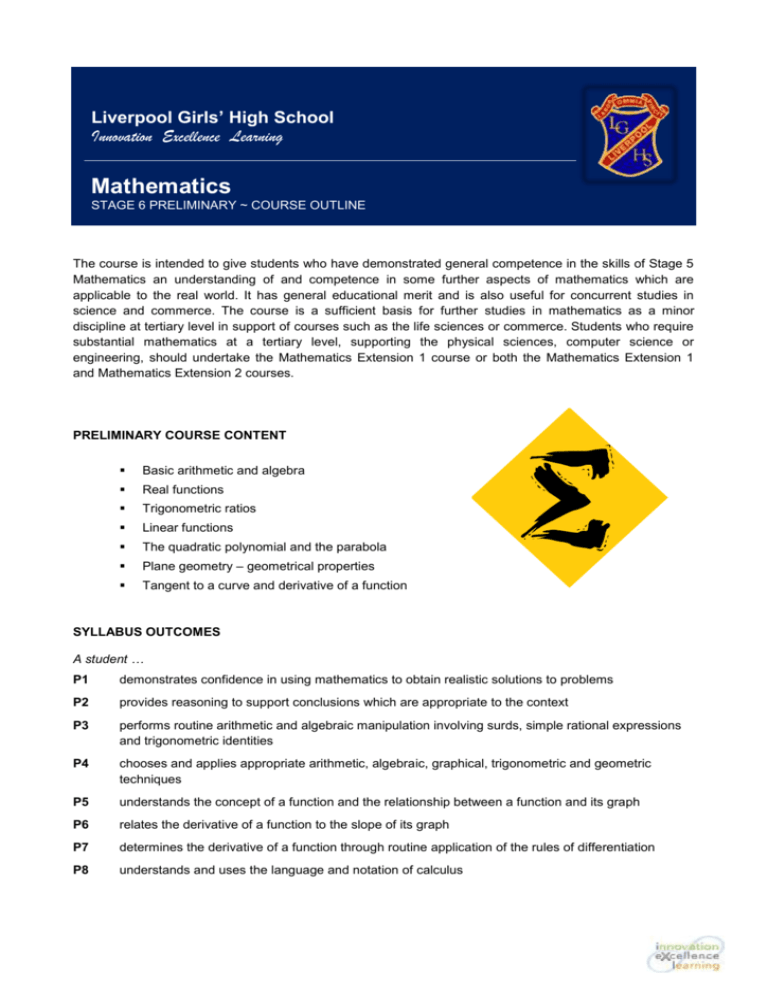
Liverpool Girls’ High School Innovation Excellence Learning Mathematics STAGE 6 PRELIMINARY ~ COURSE OUTLINE The course is intended to give students who have demonstrated general competence in the skills of Stage 5 Mathematics an understanding of and competence in some further aspects of mathematics which are applicable to the real world. It has general educational merit and is also useful for concurrent studies in science and commerce. The course is a sufficient basis for further studies in mathematics as a minor discipline at tertiary level in support of courses such as the life sciences or commerce. Students who require substantial mathematics at a tertiary level, supporting the physical sciences, computer science or engineering, should undertake the Mathematics Extension 1 course or both the Mathematics Extension 1 and Mathematics Extension 2 courses. PRELIMINARY COURSE CONTENT Basic arithmetic and algebra Real functions Trigonometric ratios Linear functions The quadratic polynomial and the parabola Plane geometry – geometrical properties Tangent to a curve and derivative of a function SYLLABUS OUTCOMES A student … P1 demonstrates confidence in using mathematics to obtain realistic solutions to problems P2 provides reasoning to support conclusions which are appropriate to the context P3 performs routine arithmetic and algebraic manipulation involving surds, simple rational expressions and trigonometric identities P4 chooses and applies appropriate arithmetic, algebraic, graphical, trigonometric and geometric techniques P5 understands the concept of a function and the relationship between a function and its graph P6 relates the derivative of a function to the slope of its graph P7 determines the derivative of a function through routine application of the rules of differentiation P8 understands and uses the language and notation of calculus BOSTES PRELIMINARY ASSESSMENT INFORMATION Component Description Weighting A. Concepts, skills and techniques Use of concepts, skills and techniques to solve mathematical problems in a wide range of theoretical and practical contexts 50 B. Reasoning and communication Application of reasoning and communication in appropriate forms to construct mathematical arguments and proofs and to interpret and use mathematical models 50 100 EVIDENCE OF LEARNING (Assessment) Task No. Targeted Outcomes Learning Context Task Weighting Date Due Marks A B 1 P2–4 Algebra, numbers and surds, functions and their graphs, graphs and inequations 2 P2–5 Trigonometry, co-ordinate geometry, indices and logarithms Assessment Task Term 2 Week 9 15% 15% 30% P2–8 Algebra, numbers and surds, functions and their graphs, graphs and in equations, trigonometry, coordinate geometry, indices and logarithms, derivatives, quadratic functions, locus and parabola End of Course Examination Term 3 Wks 9-10 20% 20% 40% 50% 50% 100 % 3 TOTAL Assessment Task Term 1 Week 10 15% 15% 30% REPORTING PERFORMANCE AND ACHIEVEMENT IN PRELIMINARY COURSES The Common Grade Scale shown below is used to report student achievement and performance in the Preliminary Stage 6 year in all NSW schools. The Common Grade Scale describes performance and achievement at each of five grade levels. A B C D E The student demonstrates extensive knowledge of content and understanding of course concepts, and applies highly developed skills and processes in a wide variety of contexts. In addition the student demonstrates creative and critical thinking skills using perceptive analysis and evaluation. The student effectively communicates complex ideas and information. The student demonstrates thorough knowledge of content and understanding of course concepts, and applies well-developed skills and processes in a variety of contexts. In addition the student demonstrates creative and critical thinking skills using analysis and evaluation. The student clearly communicates complex ideas and information. The student demonstrates sound knowledge of content and understanding of course concepts, and applies skills and processes in a range of familiar contexts. In addition the student demonstrates skills in selecting and integrating information and communicates relevant ideas in an appropriate manner. The student demonstrates a basic knowledge of content and understanding of course concepts, and applies skills and processes in some familiar contexts. In addition the student demonstrates skills in selecting and using information and communicates ideas in a descriptive manner. The student demonstrates an elementary knowledge of content and understanding of course concepts, and applies some skills and processes with guidance. In addition the student demonstrates elementary skills in recounting information and communicating ideas.
